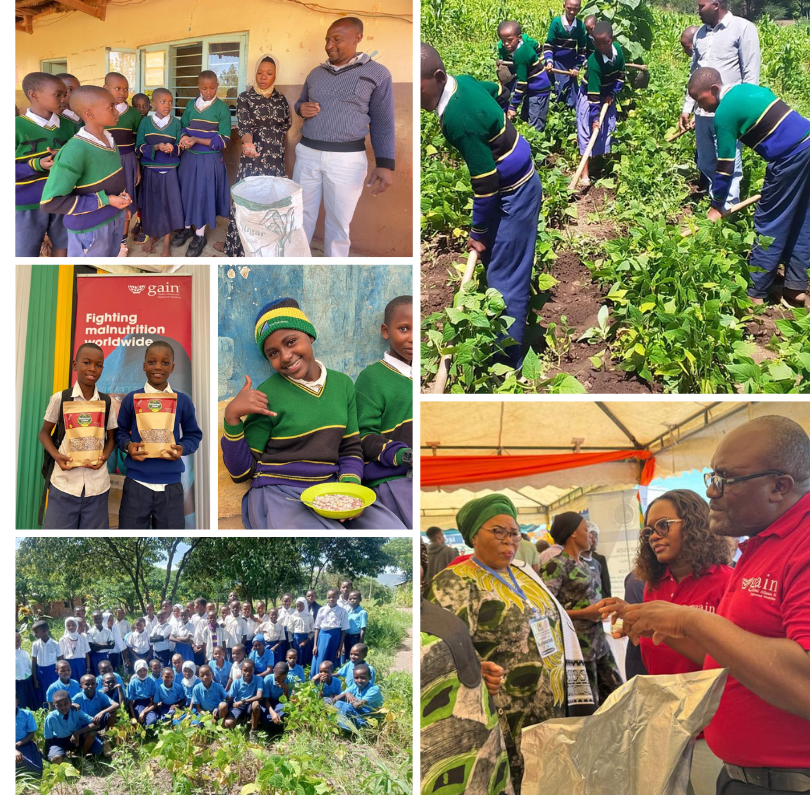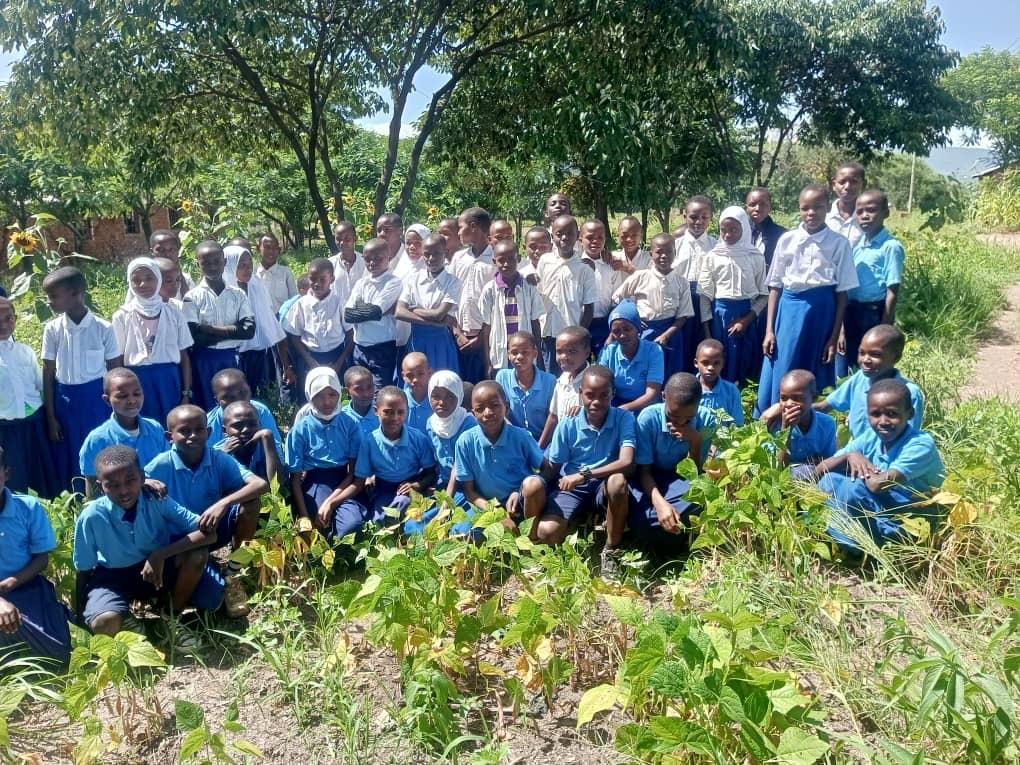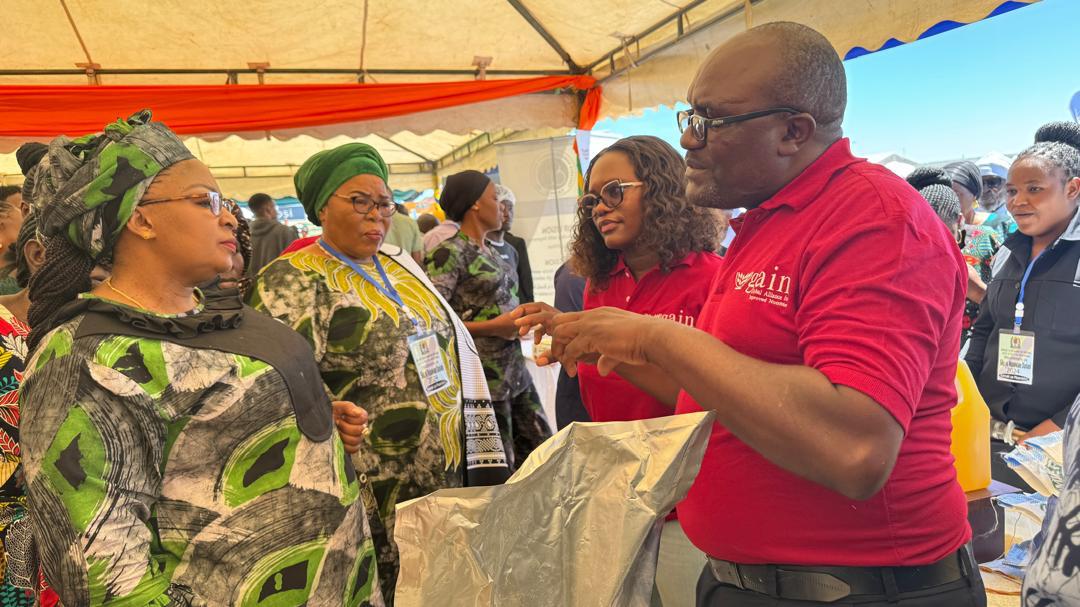Introduction
GAIN Tanzania is at the forefront of efforts to tackle micronutrient deficiencies through biofortification, an approach that enhances the nutritional content of staple crops. One of its most impactful initiatives has focused on high iron beans (HIB), a locally accepted, nutrient-rich variety introduced through partnerships with schools and farming communities. By connecting farmers to institutional markets and supporting local seed systems, GAIN is creating a sustainable, scalable model for improving diets and livelihoods. In this interview, Prisca Kokutona Rwezahura, Country Director -GAIN Tanzania, reflects on this journey- sharing insights into policy, partnerships, and what’s next for biofortification in the country.

Tanya Goel: As the Country Director of GAIN Tanzania and a key figure in the Dutch A1 funded HIB project, how do you view the role of biofortification - particularly HIB - in addressing hidden hunger and micronutrient deficiencies in the country?
Prisca Kokutona Rwezahura: Biofortification is a vital tool in combating hidden hunger. According to the 2022 Tanzania Demographic and Health Survey, about 40% of children under five and women of reproductive age suffer from iron-deficiency anaemia - well above regional averages. HIB are especially relevant because beans are a staple food in Tanzania. Substituting commonly consumed varieties with high iron ones provides a culturally acceptable and nutritionally impactful solution.
The government’s support has been encouraging. Biofortified crops have been integrated into school feeding guidelines, with schools encouraged to grow them for both consumption and education. Rural communities, which face higher rates of hidden hunger, are particularly well-placed to benefit through smallholder farming models that are both sustainable and income-generating.
Tanya Goel: Biofortification clearly depends on partnerships across sectors. How does GAIN Tanzania engage with government bodies, the private sector, and research institutions to ensure HIB - and related products - reach those who need them?
Prisca Kokutona Rwezahura: GAIN works through existing government systems rather than creating parallel structures. We collaborate closely with ministries such as Health and Local Government, which guide our implementation strategy. Agricultural extension and nutrition officers play a key role at the local level, making this a truly multi-sectoral and nationally owned effort. Research partnerships, particularly with the Tanzania Agricultural Research Institute (TARI) have been instrumental. For instance, based on their data, we shifted from the Selian variety used during the CBC (Commercialisation of Biofortified Crops) project to the higher-performing TARI 6 beans.
On the private sector side, we have partnered with Crop Bioscience to ensure seed availability. They’ve now become the primary supplier of TARI 6, and demand has surged - a strong indicator of success and scalability.
Every regional launch is done with government coordination, and site selection factors in practical constraints like water access. Strategic trade-offs help us build scalable, replicable models.
Tanya Goel: GAIN Tanzania’s role in shaping the national school feeding guidelines is a standout achievement. It shows how programmatic work can translate into long-term policy change.
Prisca Kokutona Rwezahura: Exactly. Strong government engagement ensures alignment, trust, and accountability - essential ingredients for scaling biofortification sustainably.
Tanya Goel: Looking at the broader policy environment, what is your take on how current frameworks support biofortification, and where do you see the gaps?
Prisca Kokutona Rwezahura: Tanzania has robust policies in place. The government has endorsed various biofortified seeds, and national strategies such as the 2021–2026 Multisectoral Nutrition Action Plan and the school feeding guidelines explicitly promote biofortification. The real challenge lies in implementation. For example, many rural schools have farmland, yet there is a lack of operational guidelines to support the cultivation of biofortified crops. Procurement policies could be leveraged to encourage schools to purchase and grow HIB.
We also need enabling policies in agriculture, water, and environment. Since most farming is rain-fed, erratic weather and limited access to pest control often undermine crop success. Biofortification efforts must be supported by broader systems: climate-resilient agriculture, irrigation infrastructure, and access to inputs.
Tanya Goel: Another challenge I have observed is persuading smallholder farmers to adopt biofortified crops. Has this been an issue in Tanzania?
Prisca Kokutona Rwezahura: Surprisingly, adoption hasn’t been a major barrier in our focus areas. Farmers are drawn to HIB due to better yields, disease resistance, and taste. I recall a lead farmer proudly sharing how his crop's performance made him a local reference point. In some cases, demand exceeds supply. Farmers from other regions have sought out seeds independently, which shows organic interest and word-of-mouth success.
However, market linkages are crucial. In the past, we used buy-back guarantees to de-risk the transition for farmers. Though not ideal long-term, it helped build initial trust. Ultimately, improving profitability through better yields-and ensuring reliable buyers-matters more than a price premium.
Tanya Goel: Looking ahead, if you were to introduce another biofortified crop, what would it be?
Prisca Kokutona Rwezahura: Orange-fleshed sweet potatoes come to mind. Despite being a staple, they have been underutilized due to perception issues - they were once seen as “poor man’s food.” But that is changing, especially in urban areas. With the right push, they could have significant nutritional and economic value.
Looking longer term, I believe rice has potential. It’s becoming more of a staple across socioeconomic groups. Though seen as expensive, consumption is widespread. If biofortified rice varieties are developed and made accessible, they could be transformative. In the medium term, sweet potatoes, cassava, and yams are strong candidates for scale-up.
How is GAIN supporting the QDS system to ensure smallholder farmers can access affordable, reliable HIB seeds in remote areas?
GAIN supports the Quality Declared Seed (QDS) system of HIB by strengthening local seed multipliers so that smallholder farmers can access affordable, good-quality HIB seeds closer to their farms.
This includes supporting the training of community-based seed producers on quality standards by TOSCI (Tanzania Official Seed Certification Institute) , linking them with certified seed multipliers for source seed, and working with local extension officers to monitor production. GAIN also partners with farmer groups and cooperatives to expand last-mile distribution, especially in remote areas where access to certified seed is limited. This helps ensure farmers have timely, affordable access to reliable seeds that boost nutrition and productivity.
What steps is GAIN taking to reach more schools with biofortified foods, and how is this being integrated into national school feeding systems?
In Tanzania, GAIN works closely with partners like Crop Bioscience and the TARI to strengthen local production and distribution of HIB seed for schools consumption. For example:
- In Iringa and Kilimanjaro, GAIN supports community-based seed producers, seed companies, and local farmer groups to multiply QDS HIB seed.
- These seeds are supplied to smallholder farmers, who produce surplus HIB for contributing to schools with community-based school feeding and sale to aggregators or schools' food suppliers.
- Schools (private) are encouraged to source beans directly from these HIB local farmers, boosting community incomes while improving school meal nutrition.
Demonstration and School Engagement
- Schools in Iringa and Kilimanjaro districts are used as demonstration sites for HIB. They received starter packs of HIB seed, which are grown in school farms to show students and communities how the crop works
- This practical approach helps integrate HIB into the school meal menu, alongside other staples like fortified maize flour and orange-fleshed sweet potato.
Local Stakeholder Mobilisation
GAIN mobilises a network of stakeholders -farmers, seed companies, suppliers, school administrators, local government and parent school feeding committee -to build local ownership of biofortified supply chains and feeding programmes.
Embedding in National School Feeding Policy
GAIN is supporting the formal inclusion of biofortified foods in national school feeding guidelines, aligning with global mandates (School Meals Coalition). This includes:
- Technical support to ministries and school feeding committees.
- Ensuring sourcing frameworks and procurement policies explicitly include biofortified crops.
- Financial support to convene the national school feeding guidelines meetings.

Partnerships and Sustainability
GAIN partners with district education offices, school meal committees, and local extension officers to build capacity on:
- Good Agricultural Practices for HIB.
- Nutrition education for students.
- Community sensitization on the benefits of iron-rich foods.
- By linking local supply to institutional demand, GAIN helps ensure that school meals are nutritious and farmers have a ready market.
As the program grows, what kinds of new partnerships, especially beyond government, are key to scaling HIB across Tanzania?
- Private sector seed companies and agro‑dealers. Local seed companies help produce, certify, and distribute high‑quality HIB seeds at scale.
- Farmer cooperatives & community‑based organisations (CBOs). Smallholder farmers are key to producing enough beans to supply households and institutions like schools.
- Private food processors and buyers. A big driver of scale is stable demand beyond subsistence farming - processors and bulk buyers create that.
- NGOs and development partners. NGOs fill technical, social, and logistical gaps that government alone cannot address.
- Research institutions. Continuous improvement in seed varieties and agronomic practices keeps HIB competitive and farmer‑preferred.
